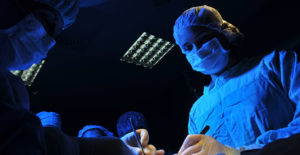Throat Cancer Treatments

Throat cancer may affect several portions of the throat. Although it begins in one area, it can quickly spread if left unmanaged.
Coughing, hoarseness, pain, or a lump in the throat can all be signs that throat cancer is present. Luckily, there are several treatments available for these cancers. Depending on what stage the cancer has reached, a doctor will help decide which option will be most effective for each person.
Targeted Drug Therapy, Radiation, and Chemotherapy
Targeted drug therapy uses specific drugs designed get in the way of throat cancer's tendency to grow uncontrollably. With radiation, beams of extremely high energy are directed at the cancer in an attempt to kill the mutating cells. This may be sufficient in the beginning stages of some throat cancers; for very advanced stages it may only help manage symptoms and provide comfort. Chemotherapy uses specific chemicals in an attempt to kill the disease. However, it comes with a host of side effects, and this must be weighed against the advance of the cancer. These treatments are often used in tandem as a more effective means of thoroughly eradicating cancerous cells.
Surgery
Depending on the severity and size of the cancer, surgery may be performed to remove any tumors present. As the cancer progresses, more and more intensive surgery must be performed. In the early stages, the tumors themselves may be all that is removed. As it progresses and invades further structures of the throat, parts of the throat or related anatomical structures (such as the voice box) may be removed as well.
If the entire voice box must come out, a tracheotomy is used to link the windpipe to a “stoma,” or hole in the skin of the throat to allow for continued breathing, speaking, and swallowing. Some cancers may spread far enough that doctors will need to remove the lymph nodes if they become infected as well.
Therapy
Especially following extensive surgery, patients may need therapy to help them recover and relearn such skills as speaking. This therapy will also teach a patient how to live effectively with a tracheotomy. Patients are taught how to care properly for the stoma, how to eat solid foods, and swallow again. Speaking may be the most challenging aspect of such treatment and therapy.








